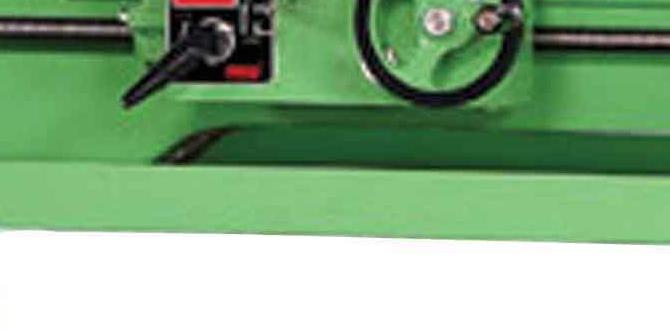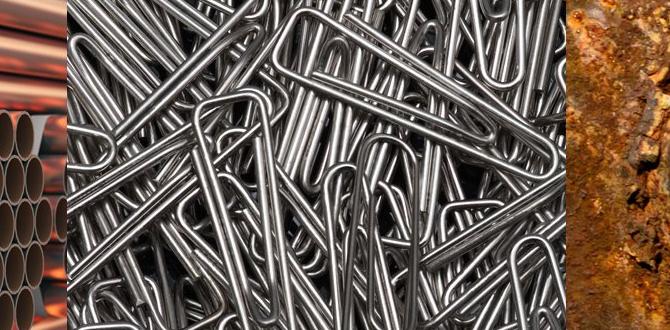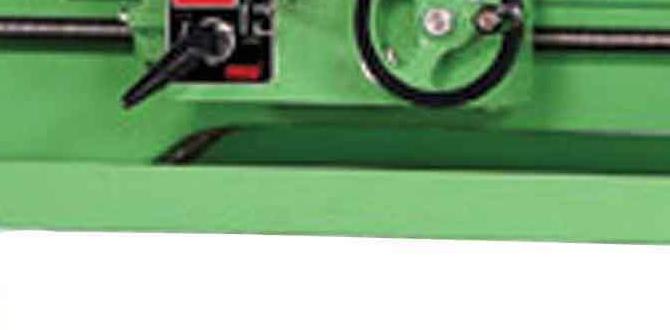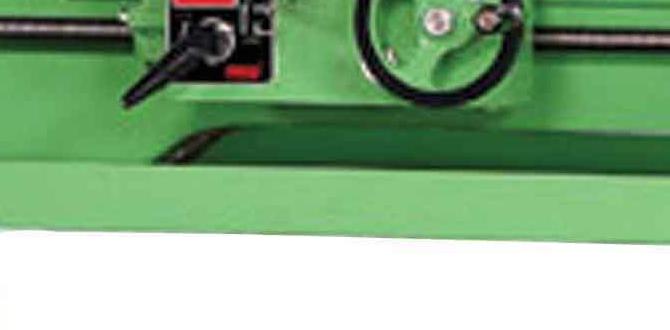Quick Summary:
A DRO (Digital Readout) for your lathe is a game-changer! It replaces manual dials with a bright digital display showing precise measurements for X and Z axes. This upgrade dramatically improves accuracy, repeatability, and your overall machining confidence, making complex tasks easier and reducing errors. Installation is straightforward for most home shop lathes.
Hey everyone, Daniel Bates here from Lathe Hub! Ever find yourself squinting at those tiny, fiddly lathe dials, trying to get a measurement just right? We’ve all been there, feeling that tug of frustration when a small error means redoing hours of work. Machining should be about precision and creativity, not fighting with imprecise feedback. The good news is, there’s a fantastic upgrade that can transform your lathe experience: a DRO, or Digital Readout.
This simple addition brings a whole new level of accuracy and ease to your lathe. Think of it like upgrading from an old flip phone to a smartphone – suddenly, everything is clearer, faster, and more capable! In this guide, we’ll walk through exactly what a DRO is, why it’s such a valuable upgrade for hobbyists and aspiring pros alike, and what to consider when choosing one. We’ll also cover the basics of installation, making it feel much less daunting. Get ready to make your lathe work smarter, not harder!
What Exactly is a DRO For Lathe?
DRO stands for Digital Readout. On a lathe, it’s a system that replaces the often hard-to-read analog dials (the round knobs you turn to move the carriage and cross-slide) with a bright, clear digital display. This display shows you the precise position of your cutting tool in real-time, usually for both the X-axis (across the lathe bed, controlled by the cross-slide) and the Z-axis (along the lathe bed, controlled by the carriage).
Essentially, a DRO takes the guesswork out of measurement. Instead of trying to interpret the graduations on a traditional dial, you get precise numerical values displayed right in front of you. This makes it incredibly easy to achieve exact dimensions, repeat settings confidently, and even perform more advanced machining operations with greater accuracy.
The Components of a Basic Lathe DRO System
A typical DRO system for a lathe consists of three main parts:
- Digital Readout (The Box): This is the main display unit. It’s usually a small electronic box with a screen that shows the numerical values for each axis. It also typically has buttons for zeroing the display, setting presets, and sometimes converting between inches and millimeters.
- Linear Scales (The Sensors): These are the “eyes” of the DRO. They are special magnetic or optical strips that are mounted onto the moving parts of your lathe (like the carriage and cross-slide). As these parts move, the scale measures the distance traveled. There are usually two scales: one for the Z-axis and one for the X-axis.
- Cables: These connect the linear scales to the DRO display box, transmitting the measurement data.
Why is a DRO an Essential Upgrade for Your Lathe?
For many home machinists and hobbyists, a DRO isn’t just a nice-to-have; it’s a crucial upgrade that significantly boosts capability and enjoyment. Let’s break down why:
1. Unparalleled Accuracy and Precision
This is the big one. Traditional lathe dials can be difficult to read accurately, especially for beginners. Small graduations can be misread, and the backlash in the leadscrews can further compound errors. A DRO eliminates this by giving you direct, clear digital readouts for every movement.
- Exact Dimensions: Need to turn a shaft to exactly 1.000 inches? With a DRO, you can move your tool until the display reads 1.000 inches, with confidence.
- Repeatability: If you need to make multiple identical parts, or if you need to come back to a specific dimension later, a DRO makes it simple. Just zero the display at your starting point and move to your desired final dimension.
2. Increased Machining Speed
While it might seem counterintuitive, a DRO can actually speed up your workflow. Instead of constantly stopping to measure with calipers or micrometers, you can often make passes until the DRO shows you’re close, then use your measuring tools for the final tiny adjustments. This reduces the number of interruptions and keeps you in the cutting zone.
3. Reduced Errors and Waste
Fewer measurement mistakes mean less scrap material. For beginners, this is invaluable. It saves you money on raw materials and the frustration of realizing you’ve turned a part too small or incorrectly. The confidence a DRO provides allows you to push your skills further without the constant fear of making a costly error.
4. Easier Complex Operations
Tasks like cutting tapers, threading, or creating precise shoulders become significantly simpler with a DRO. You can easily track your movement along both axes simultaneously, making it much easier to achieve the desired angles and depths accurately.
5. Improved Confidence and Learning Curve
There’s a significant confidence boost that comes with knowing exactly where your tool is. As a beginner, this can make learning to operate a lathe much less intimidating. You can focus more on understanding cutting speeds, feeds, and tool geometry, rather than struggling with basic positioning.
For a deeper dive into the benefits of accurate measurement in machining, you can explore resources from organizations like the National Institute of Standards and Technology (NIST), which emphasizes the importance of metrology (the science of measurement) in ensuring product quality and process reliability.
6. Cost-Effectiveness
While there’s an initial investment, compared to the cost of a higher-end lathe or the cumulative cost of wasted materials, a DRO is often one of the most cost-effective upgrades you can make. The return on investment in terms of accuracy, efficiency, and reduced frustration is substantial.
Types of DRO Systems for Lathes
When you start looking for a DRO, you’ll notice a few variations. They generally fall into two main categories based on the type of scale technology used:
1. Optical Linear Scales
These use a glass scale with etched gratings. A read head moves along the scale, and an optical system detects the changes in light passing through the gratings to determine position. They are generally considered very precise and are common in higher-end industrial machines. However, they can be more sensitive to dirt, coolant, and physical shock.
2. Magnetic Linear Scales
These systems use a magnetic strip with encoded poles. A read head detects changes in the magnetic field as it moves along the strip. Magnetic scales are often more robust and resistant to workshop environments (coolant, chips, dust) than optical scales, making them a popular choice for home shop and light industrial use.
For most DIY and hobbyist machinists, magnetic DRO systems offer an excellent balance of accuracy, durability, and cost.
Choosing the Right DRO for Your Lathe
With so many options available, selecting the best DRO for your specific lathe can feel overwhelming. Here’s a breakdown of key factors to consider:
1. Lathe Size and Travel
The most critical factor is ensuring the DRO scales are long enough for your lathe’s axes. Measure the maximum travel of your cross-slide (X-axis) and carriage (Z-axis). You’ll need scales that are slightly longer than these maximum travel distances to accommodate full movement without hitting the ends of the scale.
Example: If your cross-slide travels a maximum of 6 inches, you’ll want an X-axis scale that is at least 8 or 10 inches long to give you some flex and avoid issues.
2. Scale Type (Optical vs. Magnetic)
As discussed, magnetic scales are generally recommended for home shop environments due to their resilience against coolant, chips, and dust. Optical scales can offer slightly higher theoretical precision but require more careful maintenance and protection.
3. Number of Axes
Most lathes benefit most from a 2-axis DRO (X and Z). If you have a milling attachment or plan to do significant milling on your lathe, you might consider a 3-axis DRO, though this is less common for lathe-specific upgrades.
4. Brand and Reputation
Look for reputable brands known for quality DRO systems. Reading reviews from other users of similar lathes can be very helpful. Some popular brands include iGaging, Shars, Accu-Rite, and various others found on online marketplaces.
5. Ease of Installation
While most DRO kits are designed for DIY installation, some can be more complex than others. Consider the mounting brackets and how they’ll attach to your specific lathe model. Some kits offer universal mounting, while others might require custom fabrication for optimal placement. It’s worth looking for kits specifically designed for popular lathe models if available.
6. Features
Most DROs offer basic functions like zeroing and inch/mm conversion. Some advanced features might include:
- Presetting: Ability to enter a target dimension.
- Tool Memory: Storing measurements for different tools.
- Radius/Diameter Mode: Automatically calculates radius from diameter readings, useful for turning.
- Absolute/Incremental Modes: For tracking total movement or relative movement from a zero point.
For beginners, the standard features are usually more than enough to start.
7. Price
DRO prices can vary significantly, from a couple of hundred dollars for basic kits to over a thousand for high-end industrial units. For a hobbyist lathe, a good quality magnetic 2-axis DRO can typically be found in the $200-$500 range. Determine your budget and find the best balance of features and quality within that range.
Installation: A Step-by-Step Overview
Installing a DRO system might seem intimidating, but it’s often a much more manageable process than people realize. The specific steps will vary depending on your lathe model and the DRO kit you purchase, but here’s a general outline of the process:
Step 1: Preparation and Planning
- Read the Manuals: Thoroughly read the installation manuals for both your lathe and your specific DRO kit.
- Clean Your Lathe: Ensure the mounting surfaces on your lathe are clean, free of rust, oil, and debris.
- Identify Mounting Points: Locate suitable, flat, and rigid mounting points on the stationary and moving parts of your lathe for both the scales and the readout head.
- Gather Tools: You’ll likely need basic hand tools like wrenches, screwdrivers, Allen keys, a drill, taps (if drilling and tapping is required), a deburring tool, and possibly a file or grinder for minor modifications.
Step 2: Mounting the Z-Axis Scale
The Z-axis scale typically mounts along the lathe bed and moves with the carriage, or it mounts to the apron and reads against a strip on the bed. The goal is to have the scale installed parallel to the bed, with the read head attached to the carriage.
- Secure the Scale: Attach the main body of the Z-axis scale to the lathe bed or a sturdy part of the machine’s frame. This might involve drilling and tapping new holes or using existing ones. Ensure the scale is perfectly parallel to the ways.
- Attach the Read Head: Mount the read head to the carriage of your lathe, ensuring it aligns with the scale.
- Connect the Cable: Route the Z-axis cable neatly from the read head to where you plan to mount the display. Use cable wraps or conduit to keep it tidy and prevent it from snagging.
Tip: Many DRO kits come with various brackets. You might need to adapt these or even fabricate custom ones to get a perfect fit. For inspiration on custom bracket fabrication, exploring resources on DIY machining forums or YouTube channels dedicated to metalworking can be invaluable.
Step 3: Mounting the X-Axis Scale
The X-axis scale usually mounts to the lathe bed and moves with the cross-slide assembly, or it attaches to the saddle and reads against the cross-slide.
- Secure the Scale: Install the X-axis scale onto the saddle or another stationary part of the cross-slide assembly, ensuring it’s parallel to the cross-slide ways.
- Attach the Read Head: Mount the X-axis read head onto the cross-slide itself.
- Connect the Cable: Connect the X-axis cable and route it neatly to the display location.
Step 4: Mounting the DRO Display
The display unit is usually mounted in a convenient location where you can easily see it without obstructing your view of the workpiece or the cutting tool. Common places include the headstock end of the lathe, the banjo, or a custom bracket on the tool post holder.
- Position the Display: Find a secure spot. Using a magnetic base or a custom bracket to attach it firmly is recommended.
- Connect Cables: Plug the Z-axis and X-axis cables into the appropriate ports on the display unit.
Step 5: Power Up and Calibration
- Connect Power: Plug in the DRO unit according to the manufacturer’s instructions. Most run on standard AC power.
- Zeroing: Turn on the display. The axes might show random numbers. Press the ‘Zero’ button for each axis to set your starting point.
- Testing Movement: Slowly move the carriage and cross-slide. Watch the display to ensure it accurately reflects the direction and magnitude of your movements.
- Absolute/Incremental Check: Test switching between absolute and incremental modes if your DRO has these features.
- Functionality Check: Cycle through all the functions (inch/mm, presets, etc.) to ensure they work as expected.
Table: Common Installation Challenges & Solutions
| Challenge | Description | Solution |
|---|---|---|
| Scale Not Parallel | The linear scale is not perfectly aligned with the lathe’s ways, leading to inaccurate readings. | Use shims to adjust the mounting blocks. Carefully check alignment with a dial indicator or machinist’s square during installation. Ensure mounting surfaces are flat. |
| Cable Snagging | Cables are too long, loose, or routed poorly, risking damage or interference with operation. | Use cable carriers, sleeves, or conduit to keep cables tidy and protected. Ensure sufficient slack for full travel but no excess. Secure cables away from moving parts. |
| Mounting Bracket Issues | The provided brackets don’t fit the lathe well, or new mounting points are needed. | Fabricate custom brackets from steel or aluminum. This is a common task for machinists and allows for a perfect fit. Ensure material is strong enough to support the scale securely. |
| Scale Damage | Scales can be damaged by coolant, chips, or accidental impacts. | For magnetic scales, ensure protective boots or covers are in place if provided. Avoid direct coolant spray. Be mindful of swing radius and potential collisions. Keep scales clean. |
| Inaccurate Readings | The DRO shows incorrect measurements even after installation. | Double-check scale alignment (see “Scale Not Parallel”). Ensure read heads are correctly seated on scales. Verify that scales and read heads are the correct type and compatible. Resetting the DRO to factory settings might also help. |
Remember, take your time. If you’re unsure about any step, it’s better to pause and seek advice or watch detailed installation videos for your specific lathe model. There are many excellent tutorials available on platforms like YouTube from fellow machinists who have successfully installed DROs.
Maintaining Your DRO System
Once installed, a DRO system is generally very reliable, but a little basic maintenance will keep it performing at its best:
- Keep it Clean: Regularly wipe down the scales and read heads with a clean, dry cloth. For magnetic scales, a slightly damp cloth with mild soap can be used if necessary, but avoid solvents. Ensure no metal chips are left clinging magnetically.
- Protect from Coolant: While magnetic scales are more resistant, excessive prolonged exposure to cutting fluids can eventually degrade the seals or magnetic encoding. Wipe off any coolant immediately.
- Check Cable Integrity: Periodically inspect the cables for any signs of fraying or damage, especially where they flex.
- Avoid Impacts: Be careful not to bang tools or parts against the scales or read heads. They are robust, but not indestructible.
- Power Cycle if Needed: If you experience temporary glitches, cycling the power off and on can often resolve minor electronic issues.
Frequently Asked Questions (FAQ) About DRO for Lathes
Q1: Is a DRO really necessary for a home shop lathe?
A1: For serious hobbyists and anyone looking to improve their machining accuracy and reduce frustration, a DRO is highly recommended. It makes achieving precise dimensions much easier and is a worthwhile investment that significantly enhances the usability of your lathe.





